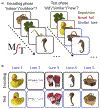Mnemonic Similarity Task: A Tool for Assessing Hippocampal Integrity
- PMID: 31597601
- PMCID: PMC6991464
- DOI: 10.1016/j.tics.2019.08.003
Mnemonic Similarity Task: A Tool for Assessing Hippocampal Integrity
Abstract
The hippocampus is critical for learning and memory, relying in part on pattern separation processes supported by the dentate gyrus (DG) to prevent interference from overlapping memory representations. In 2007, we designed the Mnemonic Similarity Task (MST), a modified object recognition memory task, to be highly sensitive to hippocampal function by placing strong demands on pattern separation. The MST is now a widely used behavioral task, repeatedly shown to be sensitive to age-related memory decline, hippocampal connectivity, and hippocampal function, with specificity to the DG. Here, we review the utility of the MST, its relationship to hippocampal function, its utility in detecting hippocampal-based memory alterations across the lifespan, and impairments associated with clinical pathology from a variety of disorders.
Keywords: discrimination; hippocampus; mnemonic similarity; pattern separation.
Copyright © 2019 Elsevier Ltd. All rights reserved.
Figures


References
-
- Bettio LEB et al. (2017) The effects of aging in the hippocampus and cognitive decline. Neurosci. Biobehav. Rev 79, 66–86 - PubMed
-
- Price JL et al. (2001) Neuron number in the entorhinal cortex and CA1 in preclinical Alzheimer disease. Arch. Neurol 58, 1395–1402 - PubMed
-
- Campbell S et al. (2004) Lower Hippocampal Volume in Patients Suffering From Depression: A Meta-Analysis. Am. J. Psychiatry 161, 598–607 - PubMed

